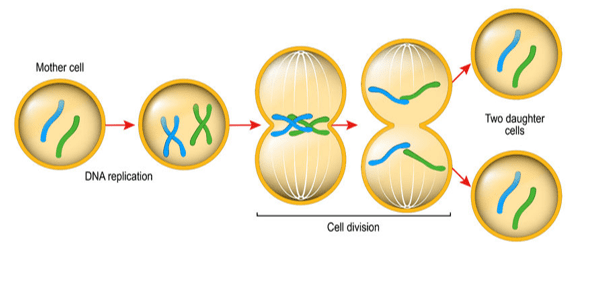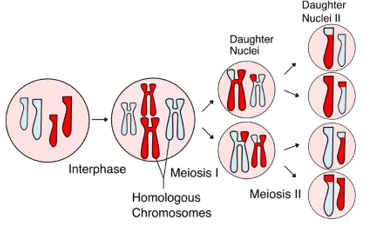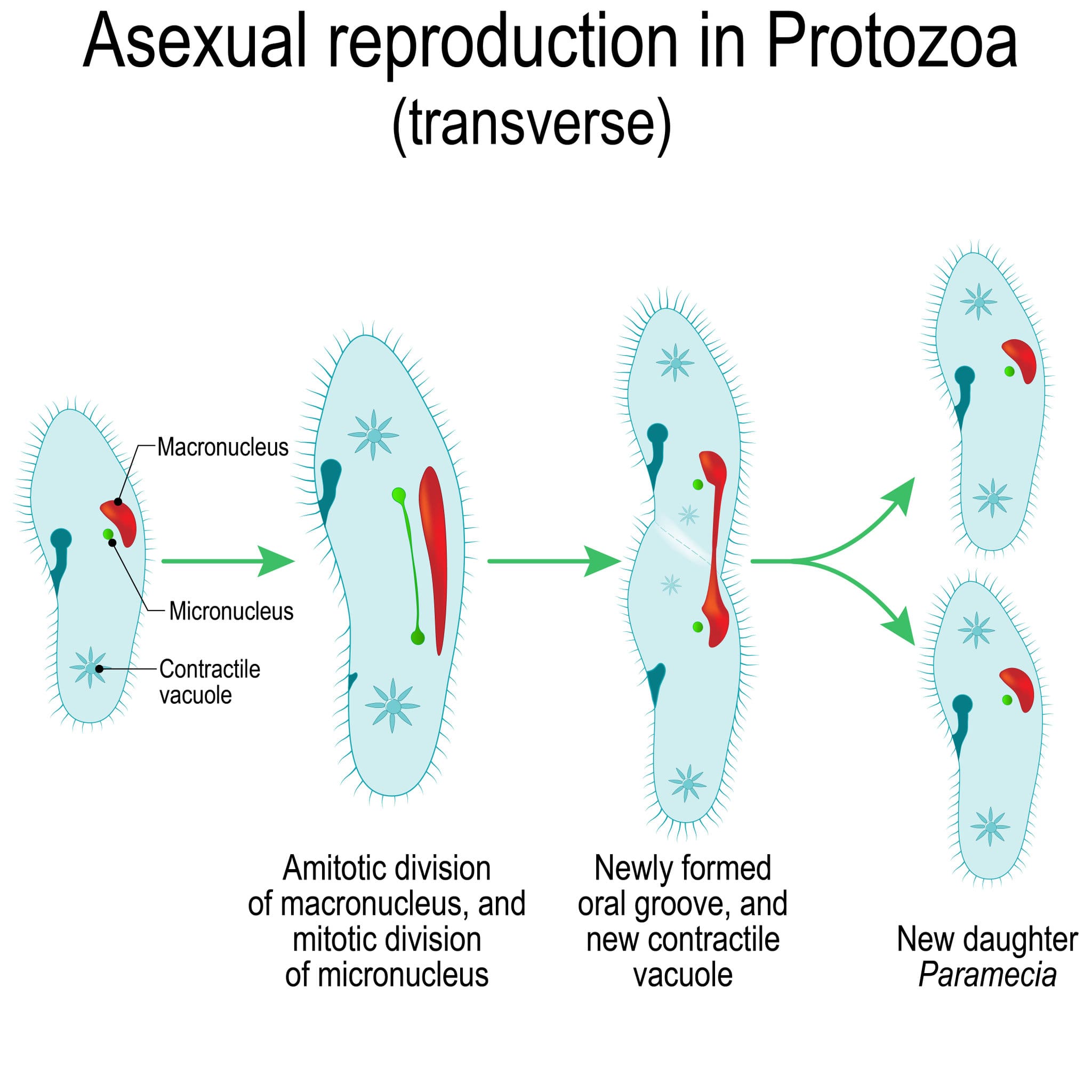In this post
Reproduction is the process by which new organisms are created, and through which genes are passed on to the future generations of these organisms. There are two different types of reproduction used by living organisms. These are asexual and sexual reproduction, and you must understand the differences between them.
Asexual reproduction
Asexual reproduction is often used by smaller organisms including fungi, bacteria, some plants such as daffodils, strawberries and brambles, and some small animals such as aphids, starfish and anemone. This type of reproduction only involves one single parent cell which divides through a process known as mitosis, to produce two daughter cells which are genetically identical to the parent cell
Key term
Asexual reproduction – a type of reproduction involving only one parent, and which produces offspring which are genetically identical to the parent.
The process of mitosis is outlined in the diagram below:

In mitosis the diploid parent cell firstly grows and duplicates its DNA so that there are two copies of each pair of chromosomes. This means that the parent cell now has 92 chromosomes in 46 pairs in total.
In the next stage of mitosis, the chromosomes condense to become shorter and fatter. The nuclear membrane breaks down and the chromosomes become free in the cytoplasm. The chromosomes then move to be lined up across the centre of the cell and cell fibres start to pull the paired chromosomes apart so that single chromosomes move to opposite sides of the cell. A membrane starts to form around each new set of chromosomes to become two separate nuclei and the two daughter cells divide.
The parent cell is described as diploid, meaning that it has a full set of paired chromosomes. For example, a human skin cell is diploid and contains 23 pairs of chromosomes (46 chromosomes in total). Each of these genetically identical daughter cells are also diploid and are known as clones as they contain the same chromosomes and combinations of genes as the parent cell and each other.
As division of a diploid cell by mitosis produces two cells which contain identical sets of chromosomes, it can be used to make new cells during the growth of an organism and repairing tissues such as skin or muscle. During the growth and repair of human skin the skin cells reproduce asexually through the process of mitosis to produce new skin cells. Each of which are diploid and therefore also contain 23 pairs of chromosomes. All your skin cells are genetically identical and unique to you. Therefore, forensic scientists can identify people who have committed crimes using samples of their skin cells. Asexual reproduction can also be used by gardeners to produce clones of plants. Asexual reproduction has both advantages and disadvantages.
Advantages
As asexual reproduction only involves a single parent, there is no need to find a mate or another parent cell. This makes the reproductive process very fast. An advantage of asexual reproduction therefore is that it produces large numbers of offspring in a very short space of time.
Disadvantages
However, as each of the daughter cells produced is genetically identical to each other and the parent cell, this means that there is no genetic variation within the population. Therefore, if one individual had a genetic mutation, the whole population would have the same mutation. This could lead to whole populations being destroyed by changes in the environmental conditions or diseases to which the organisms have no resistance.
Sexual reproduction
Sexual reproduction is used by larger animals and flowering plants and involves the process of fertilisation. Fertilisation involves the fusion of a male and female gamete. In animals the male gametes are found in the testes and are known as sperm cells and the female gametes are found in the ovaries and are known as egg cells.
In flowering plants, the female gametes are the egg cells found in the ovaries and the male gametes are found in the pollen. Male and female gametes are haploid cells, meaning that they only contain half the number of chromosomes as normal cells. For example, a human sperm cell contains only 23 chromosomes not 23 pairs and a human egg cell also contains 23 chromosomes.
The gametes are produced by a type of cell division known as meiosis. In humans, meiosis occurs in the ovaries and testes, meaning that in humans the only haploid cells are the sperm and egg cells

Division of a diploid parent cell by the process of meiosis produces four haploid daughter cells. Each of these haploid daughter cells are genetically different from each other and form the parent cell. These haploid daughter cells are the gametes. The diagram here outlines the process of meiosis.
In the first stage of meiosis the chromosomes in the diploid parent cell are copied so that there are 46 pairs of chromosomes. The first division then occurs where the chromosomes in the parent cell line up along the centre of the cells. In each of the pairs of chromosomes one chromosome has come from the father and one from the mother. The pairs of chromosomes are pulled apart as the cell divides into two cells. Each of the two cells created is diploid and contains a copy of each pair of chromosomes. During the first division each of the two cells produced contains a mixture of chromosomes from the father and mother. This random arrangement creates genetic variation.
Each of the two cells created then undergoes a second division where the paired chromosomes are split so one strand of each chromosome goes with a new cell.
Four new haploid daughter cells are created, all of which contain a single set of chromosomes and are genetically different and unique. These are the gametes.
As each gamete produced is genetically unique, the random combination of gametes from the mother and father is unpredictable and produces genetic variation in the offspring. Therefore, children who have the same parents will sometimes share similar features but will be completely genetically different to each other. We will explore how the random fertilisation produces genetic variation in the offspring in a later chapter.
The gametes fuse together to produce a fertilised egg known as a zygote. The zygote contains the chromosomes from both gametes and is therefore known as a diploid cell as it contains the full set of chromosomes. For example, when the human sperm cell and human egg cell fuse together, the zygote produced will contain 46 chromosomes arranged in 23 pairs. The zygote produced will undergo mitosis to produce an embryo which will continue to develop into a foetus as the pregnancy proceeds.
Key term
Zygote – the cell produced when the male gamete and female gamete fuse together.
The embryo cells are all diploid and, as they contain chromosomes inherited from both the father in the sperm cell and the mother in the egg cell, each embryo is genetically unique from its parent cells and from each other. Like asexual reproduction, sexual reproduction has both advantages and disadvantages.
Advantages
The daughter cells produced by sexual reproduction are genetically different to the parent cells meaning that genetic variation is created within the population. This variation leads to the process of natural selection and evolution where if environmental conditions were altered or if a disease spread through the population, some organisms would have resistance. These strongest organisms would survive and be able to reproduce and pass on their resistance genes to future generations, thus keeping the population going.
Disadvantages
The process of sexual reproduction involves two parent organisms. Therefore, the organisms must both be within the same area for their gametes to meet. This can be more time consuming and difficult for organisms which are isolated.
The process also takes more energy as animals and birds often need to spend time and energy to find and attract a mate before sexual reproduction can occur. Sexual reproduction takes much longer than asexual reproduction and produces a much smaller number of offspring over the lifespan of the organism.



